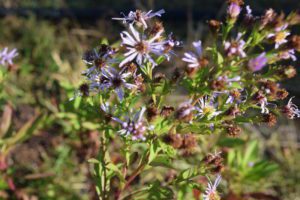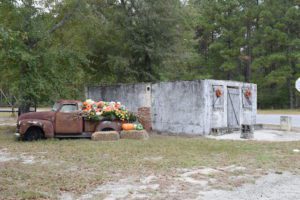
Leave seed heads and dried stems for food and cover for birds and insects during the cooler months.
After a summer of mixed rain, drought, too much rain, and then a little too much wind chances are that things are looking a little unkempt in the garden. There is a saying about plants: “They sleep, they creep, and then they LEAP.” And so, it is with vines, shrubs, perennials, and trees. Fall is a great time to take stock of what is doing well and what isn’t.
Planning a landscape should include researching the mature size and form of the plants you are going to use. Form is an important consideration because it will join the landscape together in a cohesive composition rather than just a collection of plants. When starting with one-or three-gallon size pots it might be tempting to fill in the space of a bed, but knowing the mature height and width are equally significant in placement and the quantity to buy. You can always use mulch, annuals, or ground cover to make the beds look finished. The most common mistakes made by landscapers or homeowners are plantings too close to the house and too close together. This can result in extra maintenance, pruning, or removal.
Fall is also the best time of year to plant woody shrubs and trees. They will have a chance to develop strong root systems before the spring flush of growth. Trees and shrubs planted now don’t need extra nitrogen fertilizer. A soil test may recommend raising or lowering the pH or amending any significant nutrient deficiencies. In most cases the nursery or grower has already fertilized the plants. We also don’t want to encourage top growth in the autumn that might not have a chance to harden off before frost or freezing. Water is crucial to successful installation. In the first few weeks keep the soil moist. Add compost or mulch as a top dressing but they are not usually needed in the planting hole.

I just love this picture! – Laura Lee
Back to the mess. For the same reason that we don’t add nitrogen fertilizer in the fall we should not do heavy pruning. It is always correct to remove overgrown, damaged, or diseased branches, but save heavy pruning of summer blooming trees and shrubs until late February or March. In flower beds it is a good time to divide perennials and replant or share. Clean out diseased or unsightly leaves. Leave seed pods and dried flower stalks for winter interest. Some of these will also provide food and cover to birds and insects during the colder months. Plant spring flowering bulbs in the fall and mark them so that spring annuals can be added later without disturbing the growing bulbs.
Mulch can cover a multitude of sins; keep it looking fresh but not too thick or piled up around trunks or house foundations. Mulch has so many benefits and comes in so many types. Buy mulches that are locally sourced and sustainably produced. That includes bark, compost, pine straw and wood chips. It does not include cypress or redwood mulch. While these may look nice, they are not locally or sustainably sourced.
Enjoy the cooler weather and the best season to be outdoors gardening.
For more information on planting trees and shrubs correctly https://hgic.clemson.edu/factsheet/planting-trees-correctly/









